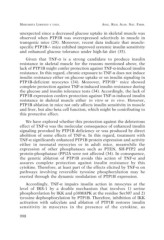Page 188 - 73_04
P. 188
MARGARITA LORENZO Y COLS. ANAL. REAL ACAD. NAC. FARM.
unexpected since a decreased glucose uptake in skeletal muscle was
observed when PTP1B was overexpressed selectively in muscle in
transgenic mice (29). Moreover, recent data indicate that muscle-
specific PTP1B-/- mice exhibed improved systemic insulin sensitivity
and enhanced glucose tolerance under high-fat diet (35).
Given that TNF-a is a strong candidate to produce insulin
resistance in skeletal muscle for the reasons mentioned above, the
lack of PTP1B might confer protection against TNF-a-induced insulin
resistance. In this regard, chronic exposure to TNF-a does not induce
insulin resistance either on glucose uptake or on insulin signaling in
PTP1B-deficient myocytes (34). Moreover, PTP1B–/– mice showed
complete protection against TNF-a-induced insulin resistance during
the glucose and insulin tolerance tests (34). Accordingly, the lack of
PTP1B expression confers protection against TNF-a-induced insulin
resistance in skeletal muscle either in vitro or in vivo. However,
PTP1B ablation in mice not only affects insulin sensitivity in muscle
and liver, but also beta cell function, which might be contributing to
this protective effect.
We have explored whether this protection against the deleterious
effect of TNF-a was the molecular consequence of enhanced insulin
signaling provoked by PTP1B deficiency or was produced by direct
abolition of some effects of TNF-a. In this regard, treatment with
TNF-a significantly enhanced PTP1B protein expression and activity
either in neonatal myocytes or in adult mice, meanwhile the
expression of other phosphatases such as PTEN, SH-PTP2 and
protein-phosphatase (PP)2A were not affected (34). In consequence,
the genetic ablation of PTP1B avoids this action of TNF-a and
assures complete protection against insulin resistance by this
cytokine. Therefore, at least part of the effects elicited by TNF-a on
pathways involving reversible tyrosine phosphorylation may be
exerted through the dynamic modulation of PTP1B expression.
Accordingly, TNF-a impairs insulin action in myocytes at the
level of IRS-1 by a double mechanism that involves 1) serine
phosphorylation by IKK and p38MAPK at the residue Ser307 and 2)
tyrosine dephosphorylation by PTP1B. Therefore, inhibition of IKK
activation with salicylate and ablation of PTP1B restores insulin
sensitivity in myocytes in the presence of the cytokine, as
998

